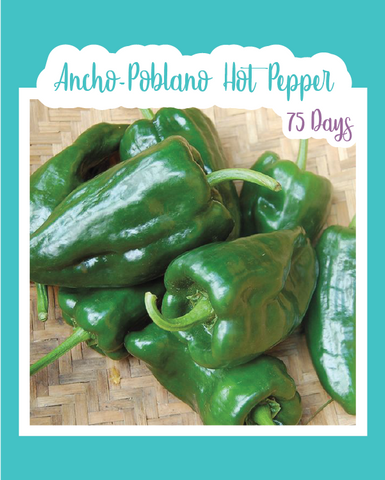
Red Scotch Bonnet Hot Pepper
Seed Count: Approx. 10 seeds
Days to Maturity: 100 Days from transplant
Description: Scotch bonnets are flavorful, fruity, smokey, and sweet with a whole lot of heat. This pepper is a must in any Caribbean cuisine. Have you made a jerk chicken or a callaloo seafood soup, and it didn't come out quite right? Then you probably didn't use a Scotch Bonnet. It adds the perfect amount of sweetness and heat to any dish. Scotch Bonnets score a heat rating of 80,000-400,000 Scoville units, which is quite hot. For scale, Jalapenos range between 2,500-8,000 Scoville units. It's also the perfect pepper to make hot sauces with, and pairs exceptionally well with tropical fruits like mangoes. The smooth, stout, thin skinned, and waxy fruits grow to about 2 inches. The shape is similar to a bonnet, which is how it got its name. The heat is similar to the habanero, however, it's a bit smaller in size, and it's a hot debate which pepper is better and hotter. The peppers are very similar and closely related to each other, and can be used instead of the other, in a pinch, but my vote forever goes to the Scotch Bonnet. Though, it is significantly harder to find, if you don't have a Caribbean presence in your area. Please remember to handle these with care, and use gloves. I have literally swollen my eyes shut, thinking I washed my hands well enough after handling these bad boys. I have never been so wrong. Totally worth it though, because that curry was immaculate.
Mint2Grow Tip: Add whole peppers to your curries and other dishes, but be sure the pod doesn't break open, or your dish may be spicier than you intended. I, however, like to cut up whole peppers to add to my curries, jerk chicken, and seafood soups for that super extra spicy kick, since I have island gyal running through my blood, and like my curries and jerk chicken spicier than most. I also dry super hot peppers and make pepper flakes with them; my husband sprinkles them literally on everything, and doesn't eat a meal without them.
How To Grow
Sowing: Start pepper seeds indoors in peat pots, about 8 weeks before your last expected spring frost. Sow them 1/4 of an inch deep, and keep the soil at 80-85 degrees F until they germinate. If the soil is too cold it may not germinate. I also find that the hotter the pepper is, the longer those seeds take to germinate. Provide seedlings with adequate sunlight or a grow light for 12-16 hours a day. When the outdoor temperature reaches 60-65 degrees F during the day and no less than 50 degrees F at night, you can transplant your seedlings. Space them about a foot and a half apart. Exposing the plants to the weather for several hours a day before transplanting may help prevent transplant shock. Peppers grow well in containers or raised beds. I grow mine in 5-10 gallon grow bags depending on how big the variety will eventually get. Since I live in a warmer climate, they become full sized, and can survive for over a year, so I have to take that into consideration when choosing their homes.
Growing: Keep the soil evenly moist and weeds under control. Mulching your plants may help with this. If excess heat and sun cause the plants to wilt, provide shade them with shade and ample water, but be careful not to over water them. Usually my peppers survive my hot summers, so I wouldn't worry much about it. Peppers are prone to blossom end rot, so I always make sure to start them with high amounts of nutrients, so I always mix in powdered egg shells, bone meal, and Epsom salt into the soil. I also feed them with fish emulsion and Fox Farm's Tiger Bloom, once a month, to ensure that I get lots of peppers with none of the rot. My peppers always get plagued with white flies, aphids, and scale, so an organic horticultural spray could be beneficial. Companion plant with basil, coriander, onions, spinach, and tomatoes but do not inter-plant with beans.
Harvesting: When to harvest hot peppers is basically a matter of personal preference. Generally speaking, the longer the peppers mature on the vine, the hotter they will taste. I've also found that decreasing the amount of water, as they mature, makes for significantly hotter peppers. Mature peppers will signal the plant to stop producing, so I pick them often. However, my peppers have always been productive, regardless of if I let them mature on the plant or not. Always use a knife or scissors to remove peppers from the plant to prevent damage to their fragile stems. Peppers are extremely versatile and can be used fresh, dried, or for seasoning. You can even make delicious pickled peppers or delicious pepper sauces and pastes. If you plan to save seeds, keep in mind that peppers will cross pollinate with other varieties of pepper, so isolation may be necessary to preserve its genetic purity. Allow peppers to fully mature, then cut them open, and remove the seeds. I give the seeds a little rinse, then I spread out the seeds to dry for about two weeks. Store the seeds in a cool, dry place for up to two years.




